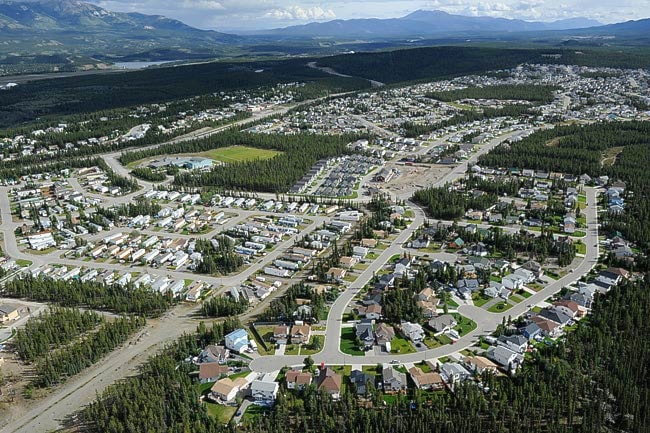Another 500 people are expected to fill up the Ingram development near Copper Ridge within the next two years, but Elijah Smith Elementary School is already at capacity.
It has been for more than three years, actually.
Elijah Smith is the only public elementary school in the region of what will soon be seven subdivisions.
In 2008, the Department of Education started looking for alternatives, realizing the neighbourhood was getting too big for one school to handle.
Takhini Elementary was identified as an overflow school for local kids who couldn’t fit in the existing facility.
In that same area, which now has about 4,500 people, Bigway Foods is the only grocery store.
Like any businessman, John O’Neil welcomes the business, but admits it has been something the store has discussed.
“Every year it gets busier,” said O’Neil, one of three managers.
He estimates about 2,000 customers go through the store each day.
“We wonder one day, what we’re going to do,” he said. “There’s no room to put another till, or anything. But right now, we’re coping fine.
“But there’s nowhere up there for the kids to go. There’s not a video store or a little cafe where kids like to hang out, so we get lots of kids coming in at night.”
Emergency Medical Services has also been feeling the stress of a growing and spreading Whitehorse.
“We have felt it as early as last year,” said director Michael McKeage. “We have put in place a second station - that’s a temporary station right now - at the corner of Hamilton Boulevard and the Alaska Highway. That’s been so effective that we’re going to now have that as a base station. We’re building there a new station, which will have a new communication centre and the larger portion of our ambulances.”
The station near the hospital will still be used as well, he said.
So the question is, how much do Whitehorse city planners consider schools, grocery stores and emergency services when planning new subdivisions?
The short answer: quite a bit.
For example, in the Copper Ridge area they reserved eight “community use” sites, as well as a few parks, not including the McIntyre subdivision, which has a lot of communal space, like the Potlatch House and medical centre.
There is a church in Granger, a continuing-care facility in Copper Ridge, Elijah Smith Elementary, Ecole Emilie Tremblay and the Bigway mall.
There is also another space in Copper Ridge, off Falcon Drive, that backs onto the continuing care facility, which is reserved for the Department of Education to build a new school if they want, said city planners Mike Ellis and Mike Gau.
And in June, the owner of a lot zoned mixed commercial/residential came to city council in hopes of changing the zoning to just residential. On July 11, council approved the decision to preserve the commercial zoning for the property off Falcon Drive, near the entrance to the Logan subdivision.
The whole basis of what to plan for, and where, is based on numbers, the planners said.
“And then neighbourhoods grow and change,” said Ellis, adding plans are flexible.
The main theory Whitehorse and most North American municipalities follow is called “smart growth practices,” and aims for nothing longer than a five-minute walk from each house to the basic amenities and public spaces, said Gau.
There is no better example of this than the new Whistle Bend development, said the planners.
When finished, Whistle Bend should be home to roughly 8,000 Yukoners.
The entire development is designed around a community square.
City planners have also designated space for two elementary schools and one high school, as well as commercial sites, parks, a community centre and a new fire station in between Whistle Bend and Porter Creek, among other things.
“The numbers are there for those,” said Ellis. “And we do put a lot of thought into the location of things.”
“But we’re the land planners, not the service planners,” said Gau, mentioning it’s up to the respective departments, or business owners, to develop what they want.
“But the land is there for them,” he said.
The shape of Whistle Bend is similar to that of Riverdale, they said, noting a main road that circles the community. The main difference is how spread out the commercial zones in Riverdale are, plus the fact that Riverdale stores have to compete with the downtown core because it’s so close.
In Whistle Bend, the commercial sites are clustered at the mouth of the community.
Copper Ridge’s main problem is that it is too spread out, said Ellis. The lack of density has stymied further commercial development.
Higher density encourages more local services, he added.
When it comes to schools, discussions haven’t started about what’s needed in Whistle Bend, said Ann MacDonald, director of policy, planning and evaluation.
And with Takhini Elementary taking care of all the overflow in Copper Ridge, the Department of Education has no plans to build another school in the area.
As for right now, the kindergarten class at Elijah Smith has already filled for the 2011-2012 school year, said MacDonald.
So, unless they have an older brother or sister already attending Elijah Smith, the only way Ingram kids can see the school across the street is through the bus window as they drive by it.
Contact Roxanne Stasyszyn at
roxannes@yukon-news.com
